How HRM Activities Enable Competitive Advantage in Organizations
VerifiedAdded on 2021/04/17
|7
|1596
|463
Essay
AI Summary
This essay delves into the critical role of Human Resource Management (HRM) in fostering organizational competitiveness, using American Express as a prime example. It meticulously examines key HRM practices including recruitment and selection, emphasizing innovative strategies to attract top talent and leverage social media. The essay further analyzes training and development programs designed to equip employees with exceptional client service skills, highlighting the benefits of global rotation programs and leadership-centric approaches. It also scrutinizes reward structures and motivational programs, showcasing how American Express customizes compensation and benefits to retain and incentivize employees. Finally, the essay explores retention strategies, such as employee-centric cultures, flexible working hours, and employee value propositions, which contribute to high employee engagement and organizational success. The conclusion underscores the importance of leadership-centric models, effective performance management, and career opportunities in achieving a sustainable competitive advantage in the financial services sector.
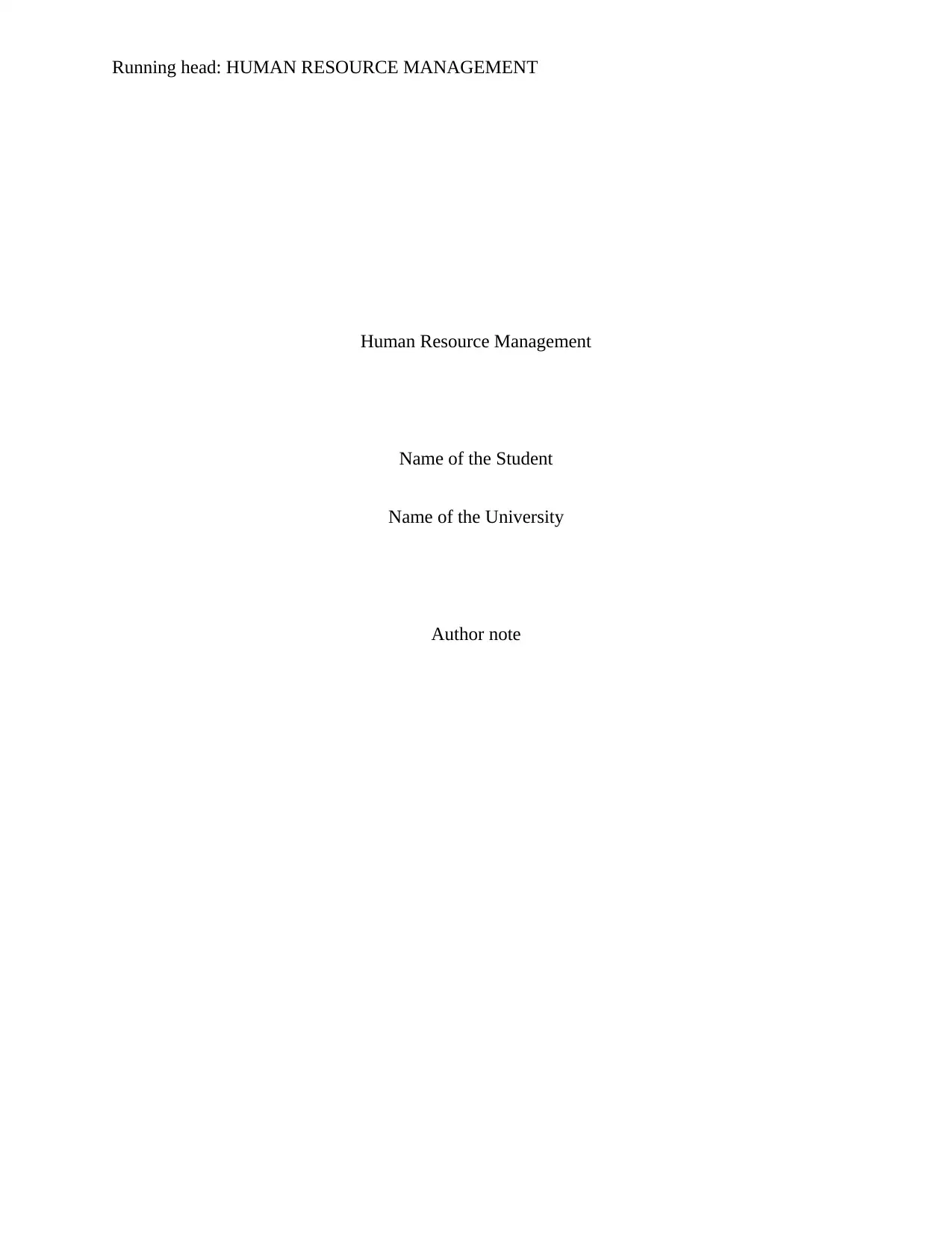
Running head: HUMAN RESOURCE MANAGEMENT
Human Resource Management
Name of the Student
Name of the University
Author note
Human Resource Management
Name of the Student
Name of the University
Author note
Paraphrase This Document
Need a fresh take? Get an instant paraphrase of this document with our AI Paraphraser
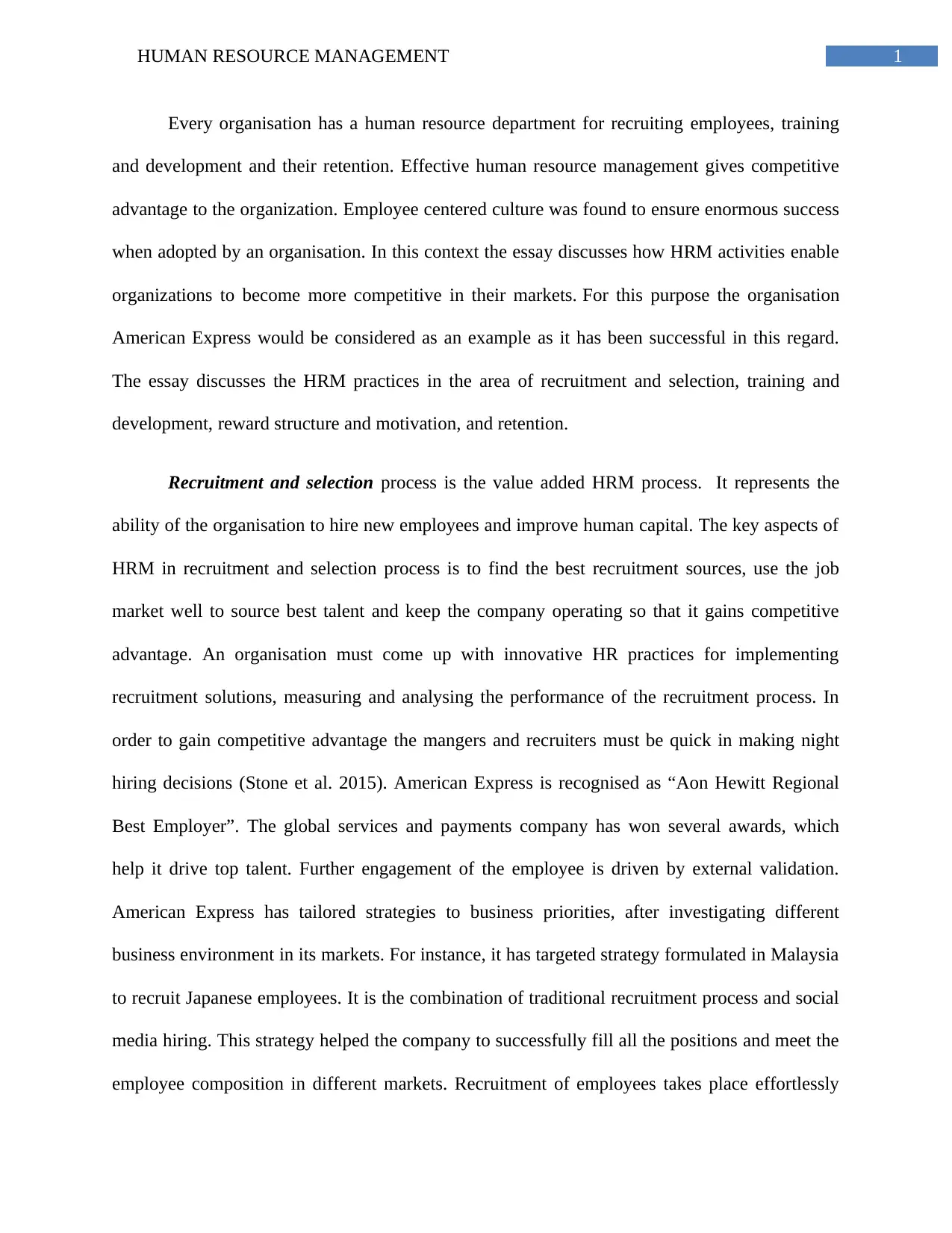
1HUMAN RESOURCE MANAGEMENT
Every organisation has a human resource department for recruiting employees, training
and development and their retention. Effective human resource management gives competitive
advantage to the organization. Employee centered culture was found to ensure enormous success
when adopted by an organisation. In this context the essay discusses how HRM activities enable
organizations to become more competitive in their markets. For this purpose the organisation
American Express would be considered as an example as it has been successful in this regard.
The essay discusses the HRM practices in the area of recruitment and selection, training and
development, reward structure and motivation, and retention.
Recruitment and selection process is the value added HRM process. It represents the
ability of the organisation to hire new employees and improve human capital. The key aspects of
HRM in recruitment and selection process is to find the best recruitment sources, use the job
market well to source best talent and keep the company operating so that it gains competitive
advantage. An organisation must come up with innovative HR practices for implementing
recruitment solutions, measuring and analysing the performance of the recruitment process. In
order to gain competitive advantage the mangers and recruiters must be quick in making night
hiring decisions (Stone et al. 2015). American Express is recognised as “Aon Hewitt Regional
Best Employer”. The global services and payments company has won several awards, which
help it drive top talent. Further engagement of the employee is driven by external validation.
American Express has tailored strategies to business priorities, after investigating different
business environment in its markets. For instance, it has targeted strategy formulated in Malaysia
to recruit Japanese employees. It is the combination of traditional recruitment process and social
media hiring. This strategy helped the company to successfully fill all the positions and meet the
employee composition in different markets. Recruitment of employees takes place effortlessly
Every organisation has a human resource department for recruiting employees, training
and development and their retention. Effective human resource management gives competitive
advantage to the organization. Employee centered culture was found to ensure enormous success
when adopted by an organisation. In this context the essay discusses how HRM activities enable
organizations to become more competitive in their markets. For this purpose the organisation
American Express would be considered as an example as it has been successful in this regard.
The essay discusses the HRM practices in the area of recruitment and selection, training and
development, reward structure and motivation, and retention.
Recruitment and selection process is the value added HRM process. It represents the
ability of the organisation to hire new employees and improve human capital. The key aspects of
HRM in recruitment and selection process is to find the best recruitment sources, use the job
market well to source best talent and keep the company operating so that it gains competitive
advantage. An organisation must come up with innovative HR practices for implementing
recruitment solutions, measuring and analysing the performance of the recruitment process. In
order to gain competitive advantage the mangers and recruiters must be quick in making night
hiring decisions (Stone et al. 2015). American Express is recognised as “Aon Hewitt Regional
Best Employer”. The global services and payments company has won several awards, which
help it drive top talent. Further engagement of the employee is driven by external validation.
American Express has tailored strategies to business priorities, after investigating different
business environment in its markets. For instance, it has targeted strategy formulated in Malaysia
to recruit Japanese employees. It is the combination of traditional recruitment process and social
media hiring. This strategy helped the company to successfully fill all the positions and meet the
employee composition in different markets. Recruitment of employees takes place effortlessly
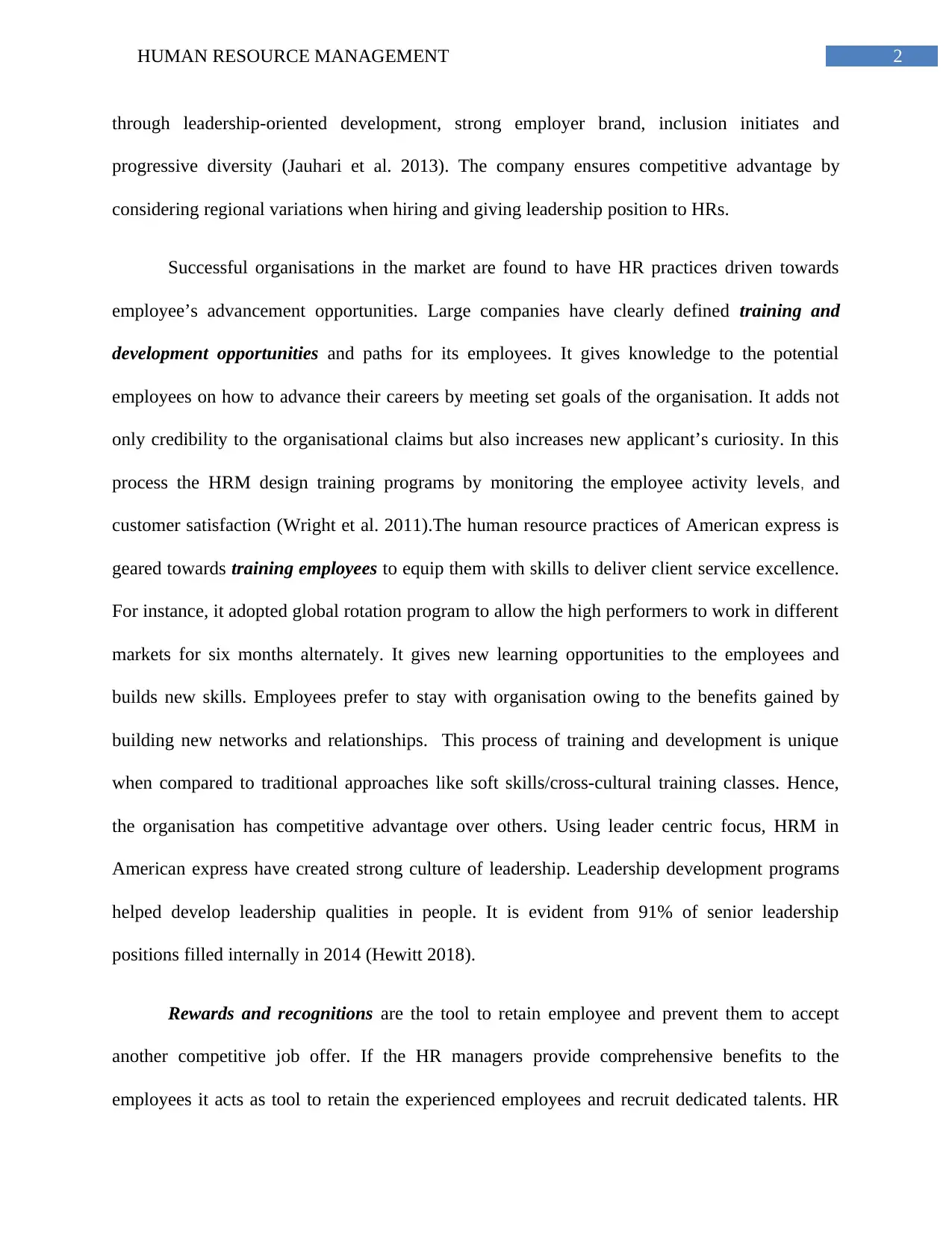
2HUMAN RESOURCE MANAGEMENT
through leadership-oriented development, strong employer brand, inclusion initiates and
progressive diversity (Jauhari et al. 2013). The company ensures competitive advantage by
considering regional variations when hiring and giving leadership position to HRs.
Successful organisations in the market are found to have HR practices driven towards
employee’s advancement opportunities. Large companies have clearly defined training and
development opportunities and paths for its employees. It gives knowledge to the potential
employees on how to advance their careers by meeting set goals of the organisation. It adds not
only credibility to the organisational claims but also increases new applicant’s curiosity. In this
process the HRM design training programs by monitoring the employee activity levels, and
customer satisfaction (Wright et al. 2011).The human resource practices of American express is
geared towards training employees to equip them with skills to deliver client service excellence.
For instance, it adopted global rotation program to allow the high performers to work in different
markets for six months alternately. It gives new learning opportunities to the employees and
builds new skills. Employees prefer to stay with organisation owing to the benefits gained by
building new networks and relationships. This process of training and development is unique
when compared to traditional approaches like soft skills/cross-cultural training classes. Hence,
the organisation has competitive advantage over others. Using leader centric focus, HRM in
American express have created strong culture of leadership. Leadership development programs
helped develop leadership qualities in people. It is evident from 91% of senior leadership
positions filled internally in 2014 (Hewitt 2018).
Rewards and recognitions are the tool to retain employee and prevent them to accept
another competitive job offer. If the HR managers provide comprehensive benefits to the
employees it acts as tool to retain the experienced employees and recruit dedicated talents. HR
through leadership-oriented development, strong employer brand, inclusion initiates and
progressive diversity (Jauhari et al. 2013). The company ensures competitive advantage by
considering regional variations when hiring and giving leadership position to HRs.
Successful organisations in the market are found to have HR practices driven towards
employee’s advancement opportunities. Large companies have clearly defined training and
development opportunities and paths for its employees. It gives knowledge to the potential
employees on how to advance their careers by meeting set goals of the organisation. It adds not
only credibility to the organisational claims but also increases new applicant’s curiosity. In this
process the HRM design training programs by monitoring the employee activity levels, and
customer satisfaction (Wright et al. 2011).The human resource practices of American express is
geared towards training employees to equip them with skills to deliver client service excellence.
For instance, it adopted global rotation program to allow the high performers to work in different
markets for six months alternately. It gives new learning opportunities to the employees and
builds new skills. Employees prefer to stay with organisation owing to the benefits gained by
building new networks and relationships. This process of training and development is unique
when compared to traditional approaches like soft skills/cross-cultural training classes. Hence,
the organisation has competitive advantage over others. Using leader centric focus, HRM in
American express have created strong culture of leadership. Leadership development programs
helped develop leadership qualities in people. It is evident from 91% of senior leadership
positions filled internally in 2014 (Hewitt 2018).
Rewards and recognitions are the tool to retain employee and prevent them to accept
another competitive job offer. If the HR managers provide comprehensive benefits to the
employees it acts as tool to retain the experienced employees and recruit dedicated talents. HR
⊘ This is a preview!⊘
Do you want full access?
Subscribe today to unlock all pages.

Trusted by 1+ million students worldwide
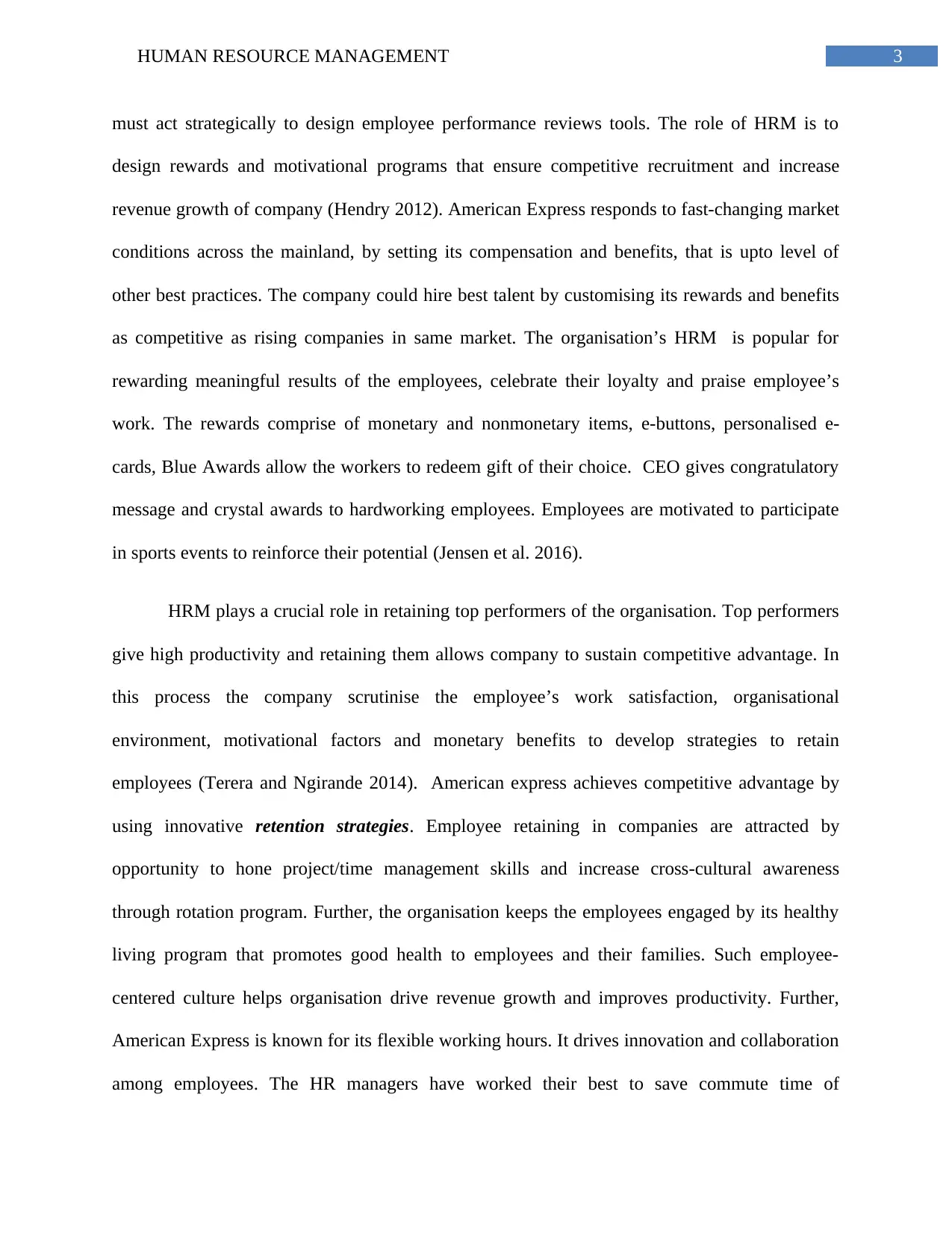
3HUMAN RESOURCE MANAGEMENT
must act strategically to design employee performance reviews tools. The role of HRM is to
design rewards and motivational programs that ensure competitive recruitment and increase
revenue growth of company (Hendry 2012). American Express responds to fast-changing market
conditions across the mainland, by setting its compensation and benefits, that is upto level of
other best practices. The company could hire best talent by customising its rewards and benefits
as competitive as rising companies in same market. The organisation’s HRM is popular for
rewarding meaningful results of the employees, celebrate their loyalty and praise employee’s
work. The rewards comprise of monetary and nonmonetary items, e-buttons, personalised e-
cards, Blue Awards allow the workers to redeem gift of their choice. CEO gives congratulatory
message and crystal awards to hardworking employees. Employees are motivated to participate
in sports events to reinforce their potential (Jensen et al. 2016).
HRM plays a crucial role in retaining top performers of the organisation. Top performers
give high productivity and retaining them allows company to sustain competitive advantage. In
this process the company scrutinise the employee’s work satisfaction, organisational
environment, motivational factors and monetary benefits to develop strategies to retain
employees (Terera and Ngirande 2014). American express achieves competitive advantage by
using innovative retention strategies. Employee retaining in companies are attracted by
opportunity to hone project/time management skills and increase cross-cultural awareness
through rotation program. Further, the organisation keeps the employees engaged by its healthy
living program that promotes good health to employees and their families. Such employee-
centered culture helps organisation drive revenue growth and improves productivity. Further,
American Express is known for its flexible working hours. It drives innovation and collaboration
among employees. The HR managers have worked their best to save commute time of
must act strategically to design employee performance reviews tools. The role of HRM is to
design rewards and motivational programs that ensure competitive recruitment and increase
revenue growth of company (Hendry 2012). American Express responds to fast-changing market
conditions across the mainland, by setting its compensation and benefits, that is upto level of
other best practices. The company could hire best talent by customising its rewards and benefits
as competitive as rising companies in same market. The organisation’s HRM is popular for
rewarding meaningful results of the employees, celebrate their loyalty and praise employee’s
work. The rewards comprise of monetary and nonmonetary items, e-buttons, personalised e-
cards, Blue Awards allow the workers to redeem gift of their choice. CEO gives congratulatory
message and crystal awards to hardworking employees. Employees are motivated to participate
in sports events to reinforce their potential (Jensen et al. 2016).
HRM plays a crucial role in retaining top performers of the organisation. Top performers
give high productivity and retaining them allows company to sustain competitive advantage. In
this process the company scrutinise the employee’s work satisfaction, organisational
environment, motivational factors and monetary benefits to develop strategies to retain
employees (Terera and Ngirande 2014). American express achieves competitive advantage by
using innovative retention strategies. Employee retaining in companies are attracted by
opportunity to hone project/time management skills and increase cross-cultural awareness
through rotation program. Further, the organisation keeps the employees engaged by its healthy
living program that promotes good health to employees and their families. Such employee-
centered culture helps organisation drive revenue growth and improves productivity. Further,
American Express is known for its flexible working hours. It drives innovation and collaboration
among employees. The HR managers have worked their best to save commute time of
Paraphrase This Document
Need a fresh take? Get an instant paraphrase of this document with our AI Paraphraser
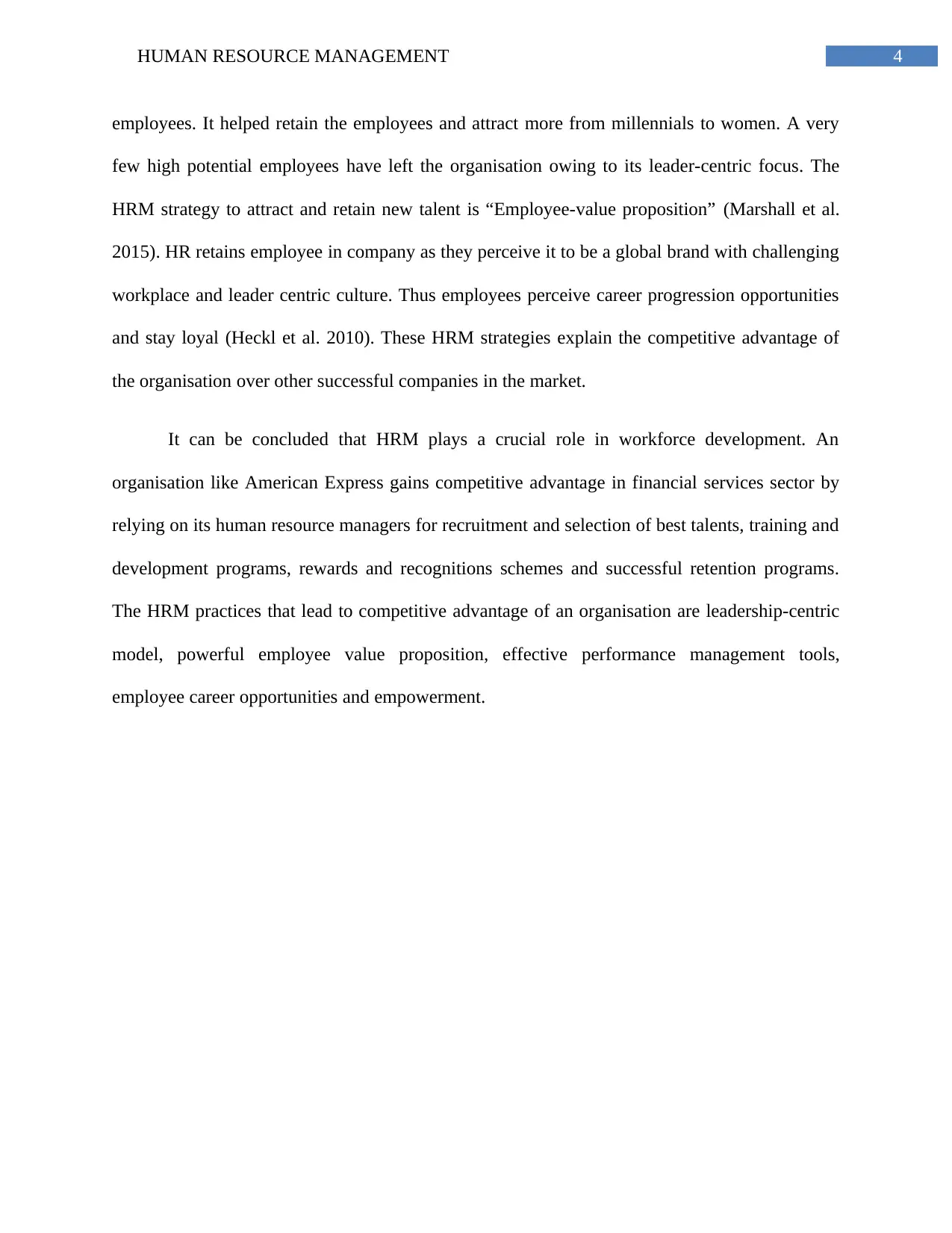
4HUMAN RESOURCE MANAGEMENT
employees. It helped retain the employees and attract more from millennials to women. A very
few high potential employees have left the organisation owing to its leader-centric focus. The
HRM strategy to attract and retain new talent is “Employee-value proposition” (Marshall et al.
2015). HR retains employee in company as they perceive it to be a global brand with challenging
workplace and leader centric culture. Thus employees perceive career progression opportunities
and stay loyal (Heckl et al. 2010). These HRM strategies explain the competitive advantage of
the organisation over other successful companies in the market.
It can be concluded that HRM plays a crucial role in workforce development. An
organisation like American Express gains competitive advantage in financial services sector by
relying on its human resource managers for recruitment and selection of best talents, training and
development programs, rewards and recognitions schemes and successful retention programs.
The HRM practices that lead to competitive advantage of an organisation are leadership-centric
model, powerful employee value proposition, effective performance management tools,
employee career opportunities and empowerment.
employees. It helped retain the employees and attract more from millennials to women. A very
few high potential employees have left the organisation owing to its leader-centric focus. The
HRM strategy to attract and retain new talent is “Employee-value proposition” (Marshall et al.
2015). HR retains employee in company as they perceive it to be a global brand with challenging
workplace and leader centric culture. Thus employees perceive career progression opportunities
and stay loyal (Heckl et al. 2010). These HRM strategies explain the competitive advantage of
the organisation over other successful companies in the market.
It can be concluded that HRM plays a crucial role in workforce development. An
organisation like American Express gains competitive advantage in financial services sector by
relying on its human resource managers for recruitment and selection of best talents, training and
development programs, rewards and recognitions schemes and successful retention programs.
The HRM practices that lead to competitive advantage of an organisation are leadership-centric
model, powerful employee value proposition, effective performance management tools,
employee career opportunities and empowerment.
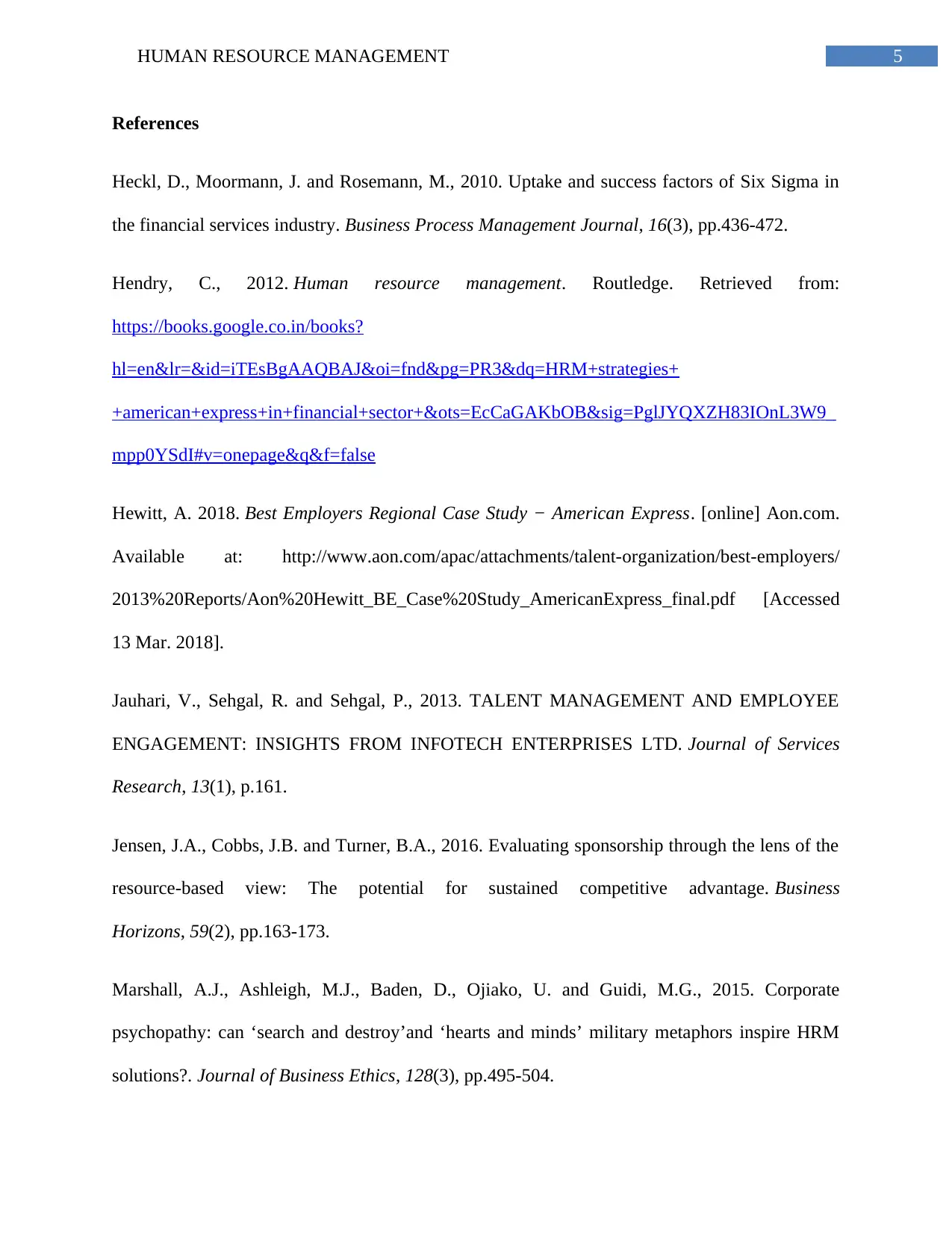
5HUMAN RESOURCE MANAGEMENT
References
Heckl, D., Moormann, J. and Rosemann, M., 2010. Uptake and success factors of Six Sigma in
the financial services industry. Business Process Management Journal, 16(3), pp.436-472.
Hendry, C., 2012. Human resource management. Routledge. Retrieved from:
https://books.google.co.in/books?
hl=en&lr=&id=iTEsBgAAQBAJ&oi=fnd&pg=PR3&dq=HRM+strategies+
+american+express+in+financial+sector+&ots=EcCaGAKbOB&sig=PglJYQXZH83IOnL3W9_
mpp0YSdI#v=onepage&q&f=false
Hewitt, A. 2018. Best Employers Regional Case Study − American Express. [online] Aon.com.
Available at: http://www.aon.com/apac/attachments/talent-organization/best-employers/
2013%20Reports/Aon%20Hewitt_BE_Case%20Study_AmericanExpress_final.pdf [Accessed
13 Mar. 2018].
Jauhari, V., Sehgal, R. and Sehgal, P., 2013. TALENT MANAGEMENT AND EMPLOYEE
ENGAGEMENT: INSIGHTS FROM INFOTECH ENTERPRISES LTD. Journal of Services
Research, 13(1), p.161.
Jensen, J.A., Cobbs, J.B. and Turner, B.A., 2016. Evaluating sponsorship through the lens of the
resource-based view: The potential for sustained competitive advantage. Business
Horizons, 59(2), pp.163-173.
Marshall, A.J., Ashleigh, M.J., Baden, D., Ojiako, U. and Guidi, M.G., 2015. Corporate
psychopathy: can ‘search and destroy’and ‘hearts and minds’ military metaphors inspire HRM
solutions?. Journal of Business Ethics, 128(3), pp.495-504.
References
Heckl, D., Moormann, J. and Rosemann, M., 2010. Uptake and success factors of Six Sigma in
the financial services industry. Business Process Management Journal, 16(3), pp.436-472.
Hendry, C., 2012. Human resource management. Routledge. Retrieved from:
https://books.google.co.in/books?
hl=en&lr=&id=iTEsBgAAQBAJ&oi=fnd&pg=PR3&dq=HRM+strategies+
+american+express+in+financial+sector+&ots=EcCaGAKbOB&sig=PglJYQXZH83IOnL3W9_
mpp0YSdI#v=onepage&q&f=false
Hewitt, A. 2018. Best Employers Regional Case Study − American Express. [online] Aon.com.
Available at: http://www.aon.com/apac/attachments/talent-organization/best-employers/
2013%20Reports/Aon%20Hewitt_BE_Case%20Study_AmericanExpress_final.pdf [Accessed
13 Mar. 2018].
Jauhari, V., Sehgal, R. and Sehgal, P., 2013. TALENT MANAGEMENT AND EMPLOYEE
ENGAGEMENT: INSIGHTS FROM INFOTECH ENTERPRISES LTD. Journal of Services
Research, 13(1), p.161.
Jensen, J.A., Cobbs, J.B. and Turner, B.A., 2016. Evaluating sponsorship through the lens of the
resource-based view: The potential for sustained competitive advantage. Business
Horizons, 59(2), pp.163-173.
Marshall, A.J., Ashleigh, M.J., Baden, D., Ojiako, U. and Guidi, M.G., 2015. Corporate
psychopathy: can ‘search and destroy’and ‘hearts and minds’ military metaphors inspire HRM
solutions?. Journal of Business Ethics, 128(3), pp.495-504.
⊘ This is a preview!⊘
Do you want full access?
Subscribe today to unlock all pages.

Trusted by 1+ million students worldwide
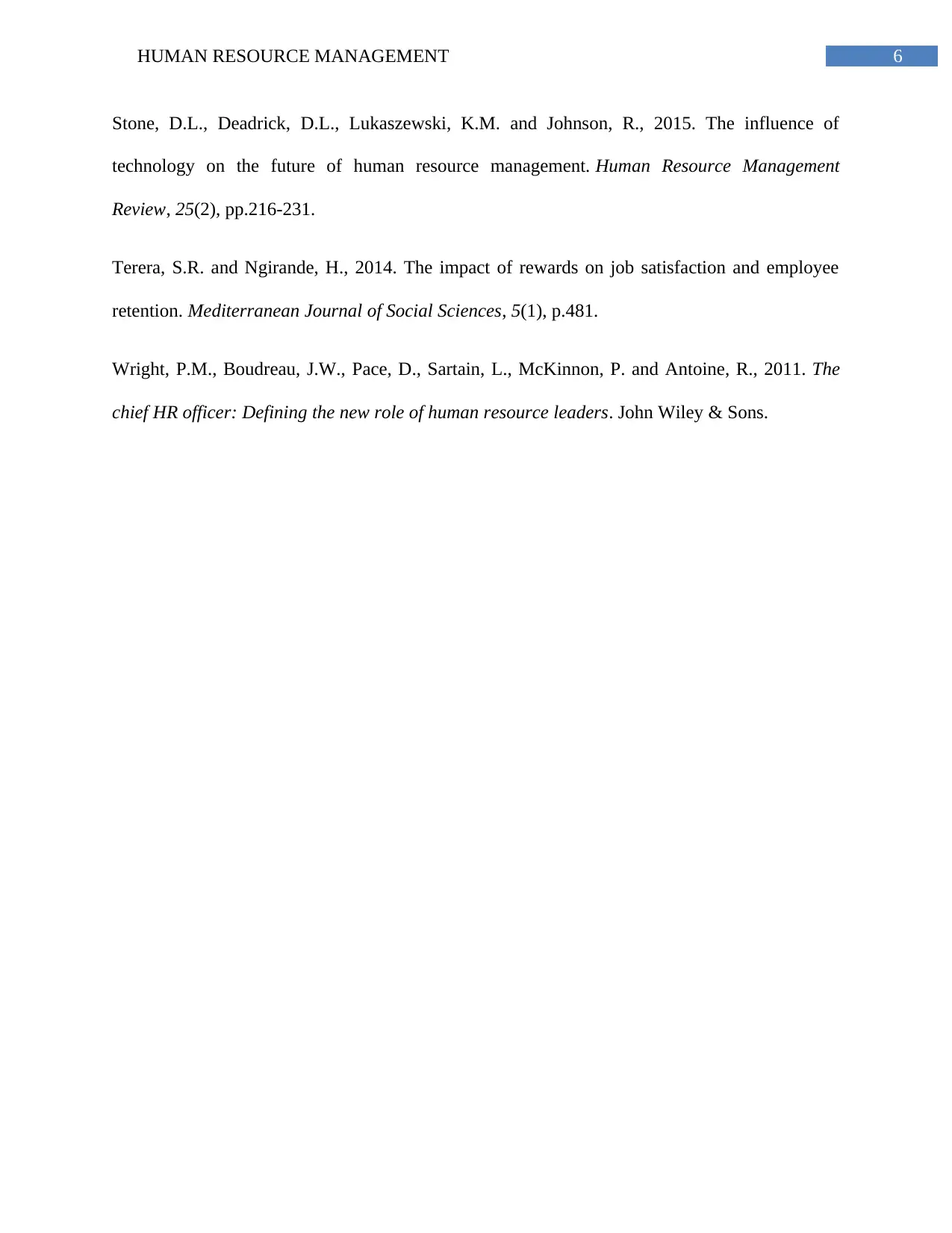
6HUMAN RESOURCE MANAGEMENT
Stone, D.L., Deadrick, D.L., Lukaszewski, K.M. and Johnson, R., 2015. The influence of
technology on the future of human resource management. Human Resource Management
Review, 25(2), pp.216-231.
Terera, S.R. and Ngirande, H., 2014. The impact of rewards on job satisfaction and employee
retention. Mediterranean Journal of Social Sciences, 5(1), p.481.
Wright, P.M., Boudreau, J.W., Pace, D., Sartain, L., McKinnon, P. and Antoine, R., 2011. The
chief HR officer: Defining the new role of human resource leaders. John Wiley & Sons.
Stone, D.L., Deadrick, D.L., Lukaszewski, K.M. and Johnson, R., 2015. The influence of
technology on the future of human resource management. Human Resource Management
Review, 25(2), pp.216-231.
Terera, S.R. and Ngirande, H., 2014. The impact of rewards on job satisfaction and employee
retention. Mediterranean Journal of Social Sciences, 5(1), p.481.
Wright, P.M., Boudreau, J.W., Pace, D., Sartain, L., McKinnon, P. and Antoine, R., 2011. The
chief HR officer: Defining the new role of human resource leaders. John Wiley & Sons.
1 out of 7
Related Documents
Your All-in-One AI-Powered Toolkit for Academic Success.
+13062052269
info@desklib.com
Available 24*7 on WhatsApp / Email
![[object Object]](/_next/static/media/star-bottom.7253800d.svg)
Unlock your academic potential
Copyright © 2020–2025 A2Z Services. All Rights Reserved. Developed and managed by ZUCOL.




